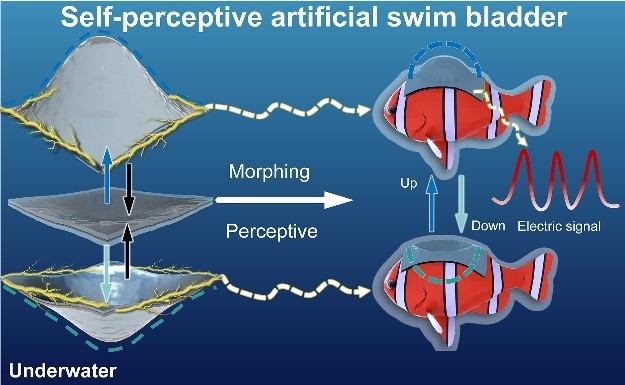Jan 8 2021
In fishes, the swim bladder acts as a resonator to sense the ambient environment, while also enabling the fish to realize a manageable vertical motion via the deflation and reversible inflation of the bladder in water.
 The self-perspective artificial swim bladder perceives the ambient environment. Image Credit: Ningbo Institute of Materials Technology and Engineering.
The self-perspective artificial swim bladder perceives the ambient environment. Image Credit: Ningbo Institute of Materials Technology and Engineering.
The research team of Professor Tao Chen from the Ningbo Institute of Materials Technology and Engineering (NIMTE) of the Chinese Academy of Sciences (CAS) was motivated by the actuating and sensory principle of swim bladders to design a new kind of soft and elastic hybrid film combined with sensing and actuating properties, which can work as a self-perceptive soft actuator. The research has been reported in the journal Nano Energy.
The team created a morphable, flexible and conductive film made by embedding conductive carbon nanotubes (CNTs) film between two expandable elastic polydimethylsiloxane (PDMS) layers.
The ultrathin film measuring around 60 μm thick was compliantly shifted onto an open container to develop a closed system (artificial swim bladder).
A change in pressure occurs between the inner side and outer side of the system when there is a variation in the pressure out of the system, which leads to a considerable deformation of the elastic film. Thus, a manageable underwater up and down motion was obtained by adjusting the additional pressure.
A decrease in the air pressure over the water led to a relative increase in the pressure within the artificial swim bladder, which in turn results in the inflation of the artificial swim bladder. As a result, a surfacing motion and additional buoyancy were realized. In the same way, the system’s diving motion was achieved by raising the outside air pressure.
The use of conductive CNT film provided the sandwiched film with outstanding sensing function to efficiently capture the underwater locomotive behavior of the actuator, thereby achieving synergetic sensing and actuation.
As proof-of-principle, the researchers developed a hollow model fish actuator based on the artificial swim bladder, with the potential to capture the vibration stimuli from the internal or external surroundings and further be pneumatically actuated to get away from hazardous regions.
The self-perceptive soft actuator created as part of this study offers a better understanding of the design of integrated and intelligent soft systems for underwater sensing behaviors and synergetic locomotion.
Journal Reference:
Liang, Y., et al. (2021) Biomimetic underwater self-perceptive actuating soft system based on highly compliant, morphable and conductive sandwiched thin films. Nano Energy. doi.org/10.1016/j.nanoen.2020.105617.